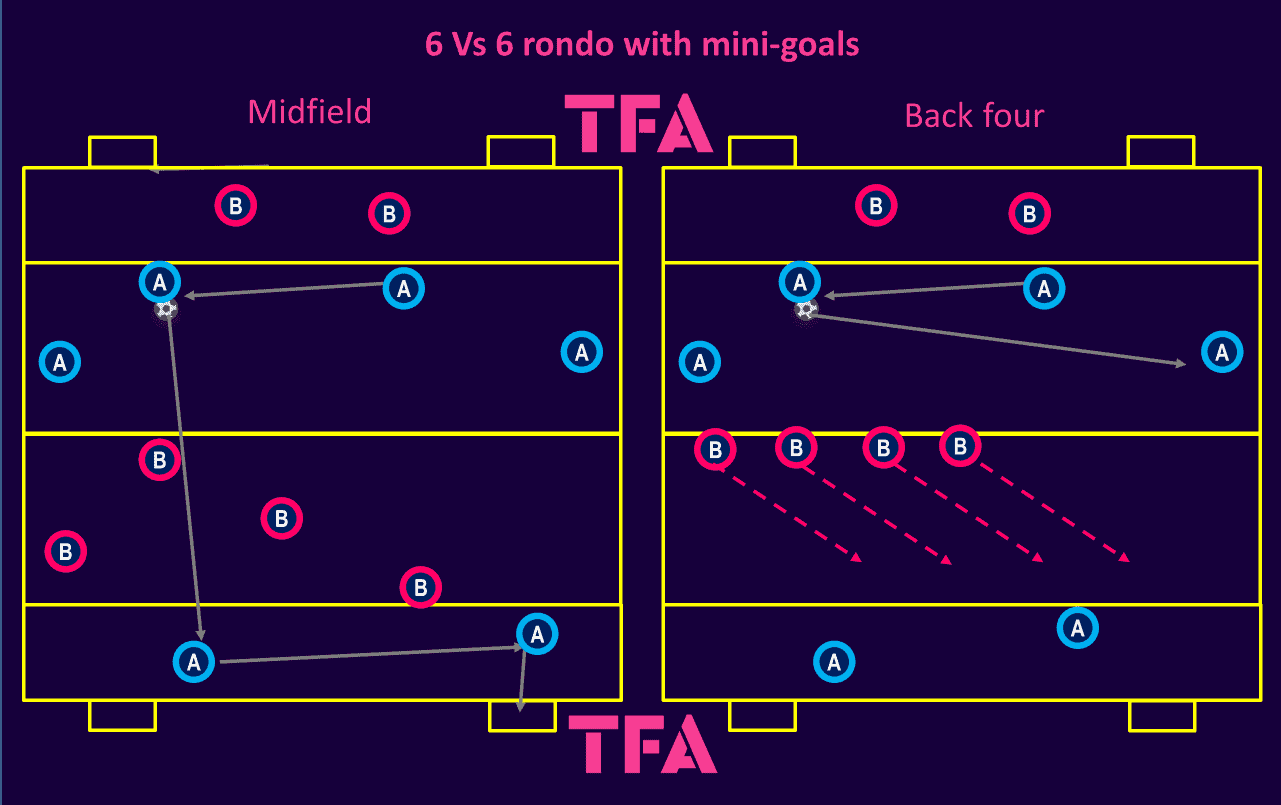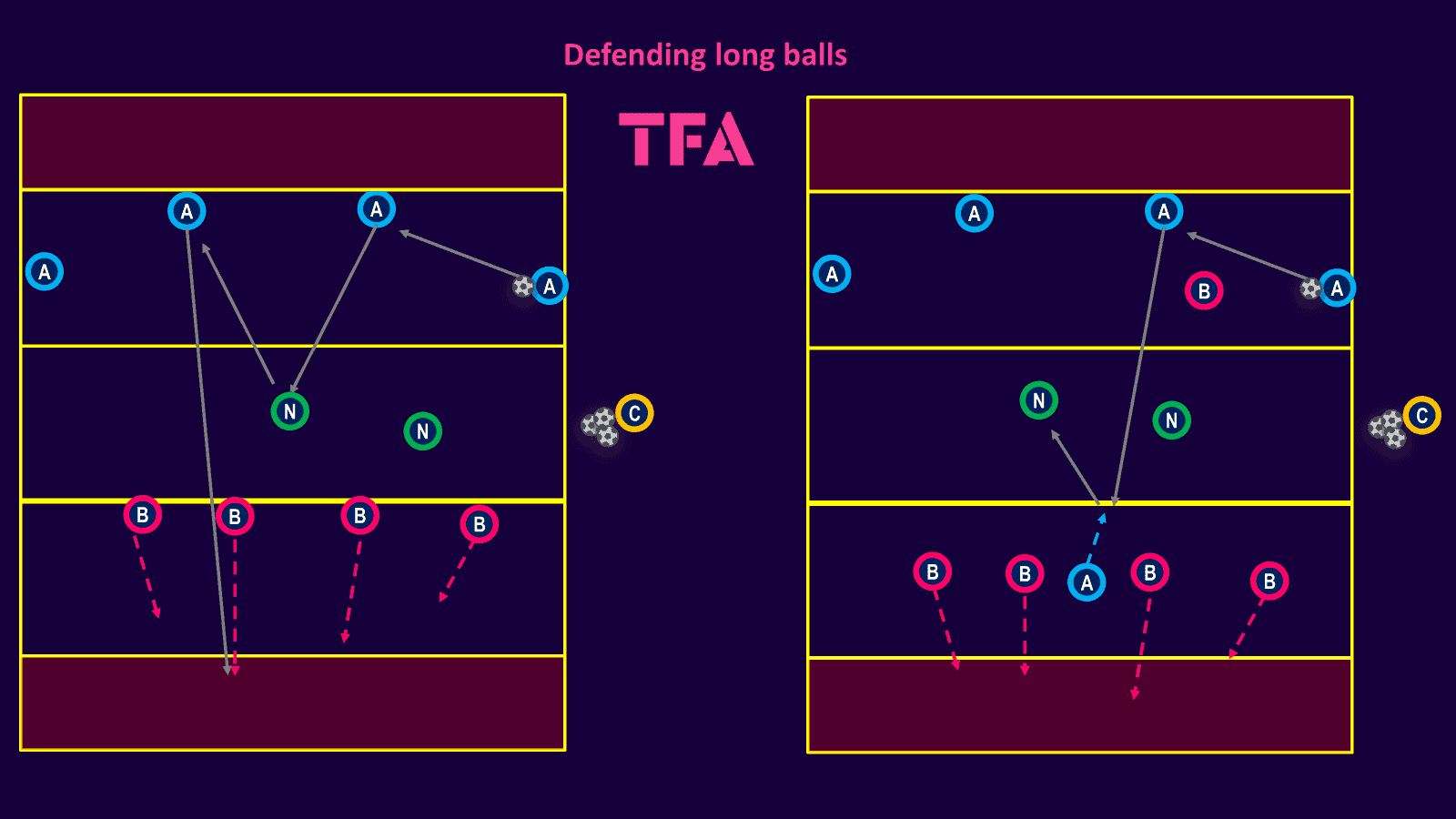A high defensive line is a tactic that allows teams to press whilst keeping the distances between their lines tight, preventing them from being played through.
When done effectively, it can suffocate opposition teams, especially those with a possession-based playing style.
However, it is not without risk.
It is a tactic that requires a supremely disciplined defensive unit with the bravery and athleticism to implement it.
A player’s natural reaction when out of possession is often to drop back and protect their goal.
This tactic takes defenders out of their comfort zone.
This high line tactical theory offers a tactical analysis of how to do a high line using La Liga’s Las Palmas as a model team.
When picturing a high line, The Netherlands’s aggressive offside trap at the 1974 World Cup may spring to mind.
More recently, an example could be Tottenham’s nine-man display against Chelsea and the image of almost all their outfield players positioned on the halfway line.
This analysis, however, focuses on the defensive line being high relative to the ball, including when teams are on the edge of their own defensive third.
Also included in this tactical analysis are ideas on practices that coaches can use to implement a high line with their teams.
Las Palmas’s (relatively) high line

The above image shows Las Palmas in a mid-block, having allowed Barcelona comfortable possession until they played into the middle third.
When Barcelona broke the first line of pressure and played into their central midfielder, Las Palmas’s back four remained about 11 yards in their half.
This is just 15 yards or so from the ball.
Barcelona’s playing preference is to combine in the central area before playing one of their forwards through on goal.
The short distance between the backline and the ball condenses the space and makes it very difficult for players, even of Barcelona’s ability, to combine in this area.
As the red area highlights, the midfielders are now only being asked to cover a 10 by 20-yard box.
Triggers to drop

The above image shows Barcelona as they are about to play a long ball in behind having been pressed this time in a deeper position.
Las Palmas’s back line was disciplined enough to push up to the halfway line and hold their ground.
This is even with Levandowski lurking behind them, attempting to stretch the team.
Here, the offside rule is being used as an extra defender.
As highlighted in the image, the right-centre back, predicting a pass into a forward’s feet, jumps to a position where he could apply pressure.
This shows how much the backline prioritised preventing Barcelona from being able to connect in front of them over defending the space behind.
The trigger in this situation, and a key trigger in implementing a high line, is the centre-back pulling his leg back to strike the ball.
As soon as the defenders see this, they must begin to drop, and ideally narrow, towards their own goal.
Their body shape is vital in allowing the backline to drop efficiently.
If they can adopt a side-on-body orientation, before the ball is played, it always them to push off on one foot to aid acceleration.
It also prevents them from having to turn 180° as the ball is played over their shoulder.
Whilst allowing them to drop off quickly and efficiently should the ball be played in behind, it also allows them to travel in the opposite direction and press players moving towards the ball.
An exception to this could be when defenders apply physical pressure on the striker who is playing with back-to-goal.
A more open, flat body shape can be used as a barrier to prevent the forward from spinning in behind.
Remaining disciplined

This image shows Barcelona’s centre-back Ronald Araújo, from a switch of play that has taken out Las Palmas’s first line of pressure, attacking the space.
As Araújo is driving with the ball at his feet into Las Palmas’s block, the expected reaction would be, with no pressure on the ball, for the midfield and defenders to drop off and defend the space behind.
Instead, As the yellow lines show, Las Palmas maintained the same level on their defensive line until Araújo was about to release the ball.
Only when the centre-back lifted his head and pulled his leg back to play the ball in behind did the backline drop, following their runners.
As well as disciplined in holding an effective offside line, they are also close enough to prevent through balls played along the ground.

Even for players of the quality of Barcelona’s, it is very hard to put a ball centrally, in-behind from this situation.
The almost inevitable outcome would be for the ball to roll to the goalkeeper, whose starting position in acting as a ‘sweeper’ is vital in these situations or out of play.
The only viable option is for the ball to be clipped at an angle towards the wide area.
This is what Araújo elects to do.
Here, the best possible outcome for Barcelona is achieved, with their winger, who managed to remain onside, gaining possession of the ball.
Because the ball has to travel so wide, this is still a very manageable situation for Las Palmas, who simply pack the box before a ball can be delivered.
Backline rondo

Whilst this analysis focused on the backline itself, the midfield being able to cover space ahead of them is also of vital importance.
This 6 Vs 6 rondo can be adapted to work on either midfield pressure and cover (shown on the left) and/or the backline shifting as a unit (shown on the right).
The exercise has two teams of six divided into four separate zones.
Each team has four players across a central zone with two players in an end zone.
The aim is for the team of four to combine before playing a pass into one of the two end players.
The two end players have two touches between them to score into the mini goals.
When the in-possession team breaks the defensive line, the defending players can attempt to recover the ball in the end zone before a goal is scored.
If the coach desires, one of the target players on the defending team can drop in after a predetermined number of passes to help regain the ball.
When working on midfield defending, the focus of the defending team should be to shift laterally and stagger their positioning.
If done correctly, this will prevent any passes from being played between them.
The ball-near player should step towards the ball when able to securely do so, with the players beside him dropping off.
This allows them to cover a lot more width whilst not allowing balls to be played between them than they could if in the same horizontal line.
When working on playing with a high backline, the aim should be for the defending four to remain as high and in as straight a line as possible in their zone—only dropping when it is required to prevent a ball from going behind them.
The defenders should be compact enough to at least make the attacking team play around, rather than through, them.
As shown on the diagram, a flat line requires players to be significantly closer together than if they could adopt a diagonal line.
The coach should also emphasise appropriate body orientation.
When directly in front of the ball, the coach may demand a flat body shape to create a bigger barrier.
When further from the ball, a side-one body shape that allows the player to drop off quickly may be encouraged.
Players must learn to shift across the line quickly and recognise when to drop.
Due to the sprints required when defending, this rondo could be used as part of speed or reactive agility work at the beginning of the session.
Defending long-balls

This semi-unopposed exercise aims for the two sets of back fours to score points by landing an aerial ball in the end (red) zone opposite them.
The practice is designed to work on the back four shifting, dropping off and stepping up appropriately.
The two neutral players (green) represent two defensive midfielders and play for whichever team is in possession.
The six in-possession players move the ball amongst them whilst the defending four shift appropriately.
The midfielders aim to set the ball back to allow one of the defenders to play a long, high ball in behind the opposition line.
As soon as the attacking player pulls his leg back to hit the long ball, the defending team should recognise the trigger and drop off to prevent the ball from landing in the end zone.
Should the ball not be played long, the defending four should immediately push back up to their original starting position.
Players should be coached on appropriate body shape as they push, drop and shift.
To progress the exercise, a forward can be added to both teams as well as pressing when out of possession; this player can then act as a target player.
The teams can now score an additional point if the striker receives the ball and combines with a supporting neutral player.
Now, they will be punished if the defending team drops at the wrong time or is unaware of the striker’s movement.
11 against 11
When the session progresses to an 11 against 11, the coach should touch on the principles already worked on.
Additionally, the coach should provide the back four with a clear line that they must hold.
Poles or cones can be used as markers to guide where the backline should attempt to advance.
In the attacking phase, the backline should be encouraged to push up in relation to the ball.
For example, this can be done by implementing a rule that all players must be in or on the halfway line when a goal is scored for that goal to count.
This encourages teams to squeeze up the pitch as they attack and leaves fewer gaps between the lines for opposition teams to exploit should they lose possession.
‘Linesman’ (additional players or coaches if available) should be used to ensure the backline keeps in sync with one another and not playing forwards onside.
Conclusion
Implementing a high line can be viewed as a high-risk, high-reward strategy.
It can be seen as going against a player’s basic instinct to defend the space in front of their goal.
However, if a team is very organized and recognises the triggers of when and how to drop off, it can be a great way of suffocating teams.
Individual players must be brave and trust the system so as not to panic and drop prematurely, playing forwards onside.






Comments